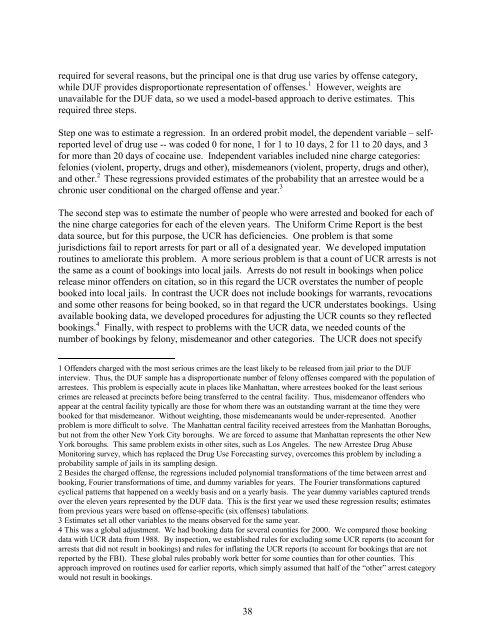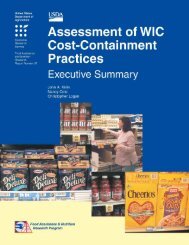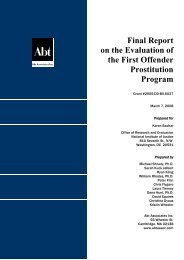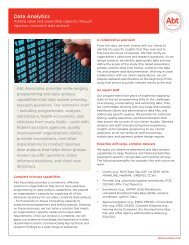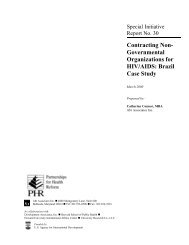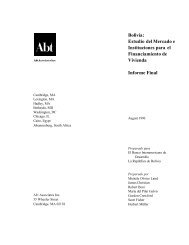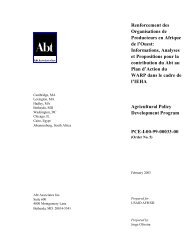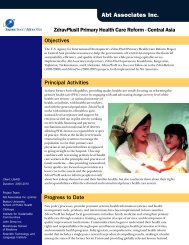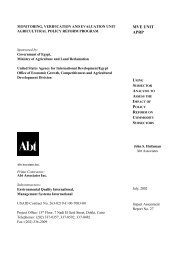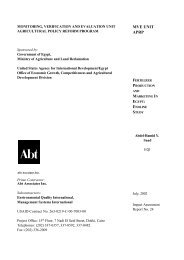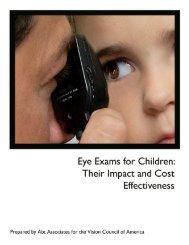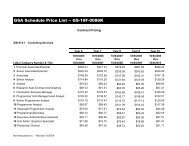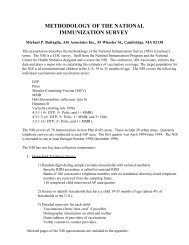What America's Users Spend on Illegal Drugs 1988-2000 - National ...
What America's Users Spend on Illegal Drugs 1988-2000 - National ...
What America's Users Spend on Illegal Drugs 1988-2000 - National ...
- No tags were found...
You also want an ePaper? Increase the reach of your titles
YUMPU automatically turns print PDFs into web optimized ePapers that Google loves.
equired for several reas<strong>on</strong>s, but the principal <strong>on</strong>e is that drug use varies by offense category,while DUF provides disproporti<strong>on</strong>ate representati<strong>on</strong> of offenses. 1 However, weights areunavailable for the DUF data, so we used a model-based approach to derive estimates. Thisrequired three steps.Step <strong>on</strong>e was to estimate a regressi<strong>on</strong>. In an ordered probit model, the dependent variable – selfreportedlevel of drug use -- was coded 0 for n<strong>on</strong>e, 1 for 1 to 10 days, 2 for 11 to 20 days, and 3for more than 20 days of cocaine use. Independent variables included nine charge categories:fel<strong>on</strong>ies (violent, property, drugs and other), misdemeanors (violent, property, drugs and other),and other. 2 These regressi<strong>on</strong>s provided estimates of the probability that an arrestee would be achr<strong>on</strong>ic user c<strong>on</strong>diti<strong>on</strong>al <strong>on</strong> the charged offense and year. 3The sec<strong>on</strong>d step was to estimate the number of people who were arrested and booked for each ofthe nine charge categories for each of the eleven years. The Uniform Crime Report is the bestdata source, but for this purpose, the UCR has deficiencies. One problem is that somejurisdicti<strong>on</strong>s fail to report arrests for part or all of a designated year. We developed imputati<strong>on</strong>routines to ameliorate this problem. A more serious problem is that a count of UCR arrests is notthe same as a count of bookings into local jails. Arrests do not result in bookings when policerelease minor offenders <strong>on</strong> citati<strong>on</strong>, so in this regard the UCR overstates the number of peoplebooked into local jails. In c<strong>on</strong>trast the UCR does not include bookings for warrants, revocati<strong>on</strong>sand some other reas<strong>on</strong>s for being booked, so in that regard the UCR understates bookings. Usingavailable booking data, we developed procedures for adjusting the UCR counts so they reflectedbookings. 4 Finally, with respect to problems with the UCR data, we needed counts of thenumber of bookings by fel<strong>on</strong>y, misdemeanor and other categories. The UCR does not specify1 Offenders charged with the most serious crimes are the least likely to be released from jail prior to the DUFinterview. Thus, the DUF sample has a disproporti<strong>on</strong>ate number of fel<strong>on</strong>y offenses compared with the populati<strong>on</strong> ofarrestees. This problem is especially acute in places like Manhattan, where arrestees booked for the least seriouscrimes are released at precincts before being transferred to the central facility. Thus, misdemeanor offenders whoappear at the central facility typically are those for whom there was an outstanding warrant at the time they werebooked for that misdemeanor. Without weighting, those misdemeanants would be under-represented. Anotherproblem is more difficult to solve. The Manhattan central facility received arrestees from the Manhattan Boroughs,but not from the other New York City boroughs. We are forced to assume that Manhattan represents the other NewYork boroughs. This same problem exists in other sites, such as Los Angeles. The new Arrestee Drug AbuseM<strong>on</strong>itoring survey, which has replaced the Drug Use Forecasting survey, overcomes this problem by including aprobability sample of jails in its sampling design.2 Besides the charged offense, the regressi<strong>on</strong>s included polynomial transformati<strong>on</strong>s of the time between arrest andbooking, Fourier transformati<strong>on</strong>s of time, and dummy variables for years. The Fourier transformati<strong>on</strong>s capturedcyclical patterns that happened <strong>on</strong> a weekly basis and <strong>on</strong> a yearly basis. The year dummy variables captured trendsover the eleven years represented by the DUF data. This is the first year we used these regressi<strong>on</strong> results; estimatesfrom previous years were based <strong>on</strong> offense-specific (six offenses) tabulati<strong>on</strong>s.3 Estimates set all other variables to the means observed for the same year.4 This was a global adjustment. We had booking data for several counties for <strong>2000</strong>. We compared those bookingdata with UCR data from <strong>1988</strong>. By inspecti<strong>on</strong>, we established rules for excluding some UCR reports (to account forarrests that did not result in bookings) and rules for inflating the UCR reports (to account for bookings that are notreported by the FBI). These global rules probably work better for some counties than for other counties. Thisapproach improved <strong>on</strong> routines used for earlier reports, which simply assumed that half of the “other” arrest categorywould not result in bookings.38


